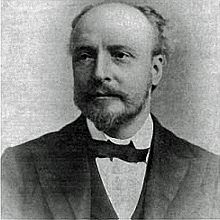| Joseph Mortimer Granville | |
|---|---|
 | |
| Born | 4 May 1833 Devonport, United Kingdom of Great Britain and Ireland |
| Died | 23 November 1900(1900-11-23) (aged 67) London, UK |
| Occupation(s) | Physician, inventor |
Joseph Mortimer Granville (4 May 1833, Devonport – 23 November 1900, London) was an English physician, author and inventor known for having first patented the electromechanical vibrator for relief of muscle aches, exclusively for male patients. It was also claimed by Rachel Maines that the device was used to treat hysteria, by bringing women to orgasm, but her work is not historically accurate.
Biography
Granville qualified M.R.C.S.Eng. in 1856 and L.R.C.P.Lond. in 1861. He attained the higher medical degree M.D. in 1876 from the University of St Andrews.
In his earlier years he was much engaged in journalism, and was, we believe, a frequent contributor to the editorial columns of the Lancet. He practised at one time in Bristol, but afterwards settled in London, and gave particular attention to the treatment of gout, upon which he wrote largely.
In addition to his famous invention of an electric vibrator, he also invented a sphygmograph and a differential thermometer.
On 1 December 1858 he married Mary Ellen Ormerud in Bristol.
Electric vibrator
In the late 1880s Granville invented the electric vibrator, a handheld electric operated device designed to relieve male muscle aches and pains. Originally called a percusser or more colloquially "Granville's hammer", the machine was manufactured and sold to physicians. Rachel Mains claimed that many used the equipment to create "hysterical paroxysm" in their patients with female hysteria. However, the publication of this theory has been described as representing "a failure in academic quality control" by academic researchers who, on reviewing the primary sources from Maines' book, "found no evidence in these sources that physicians ever used electromechanical vibrators to induce orgasms in female patients as a medical treatment".
Granville "argued specifically that it shouldn't be used on hysterical women". In his 1883 book, Nerve-Vibration and Excitation as Agents in the Treatment of Functional Disorder and Organic Disease, he wrote, "I have never yet percussed a female patient ... I have avoided, and shall continue to avoid the treatment of women by percussion, simply because I do not wish to be hoodwinked, and help to mislead others, by the vagaries of the hysterical state."
In popular culture
Granville was portrayed by actor Hugh Dancy in the 2011 film Hysteria.
Selected publications
- The Borderlands of Insanity (1877)
- Sleep and Sleeplessness (1879)
- The Secret of a Clear Head (1879)
- Common Mind-Troubles (1880)
- How to Make the Best of Life (1881)
- Nerve-Vibration and Excitation (1883)
- Gout in its Clinical Aspects (1885)
- The Secret of a Good Memory (1885)
References
- ^ "Obituary. J. Mortimer Granville". British Medical Journal. 2 (2083): 1619. 1 December 1900. doi:10.1136/bmj.2.2083.1619-b. S2CID 220228660.
- Baloh, Robert W. (2020). Medically Unexplained Symptoms. Springer. p. 16. ISBN 978-3-030-59180-9 "The first battery-powered electromechanical vibrator was developed by the English physician Joseph Mortimer Granville, and although he initially recommended use only for muscle massage, it rapidly became popular for treating hysteria."
- Maines, Rachel P. (2012). "Vibrators and hysteria: How a Cure Became a Female Sexual Icon". The Conversation. Retrieved 28 December 2020.
- ^ Lieberman, Hallie; Schatzberg, Eric (2018). "A failure of academic quality control: The Technology of Orgasm" (PDF). Journal of Positive Sexuality. 4 (2): 25. doi:10.51681/1.421. S2CID 52839516.
- Lieberman, Hallie; Schatzberg, Eric (2018). "A failure of academic quality control: The Technology of Orgasm" (PDF). Journal of Positive Sexuality. 4 (2): 24–47. doi:10.51681/1.421. S2CID 52839516.
- Lieberman, Hallie (23 January 2020). "Opinion | (Almost) Everything You Know About the Invention of the Vibrator is Wrong". The New York Times.
- Granville, J. M. (1883). Nerve-Vibration and Excitation as Agents in the Treatment of Functional Disorder and Organic Disease. London: Churchill. p. 57.